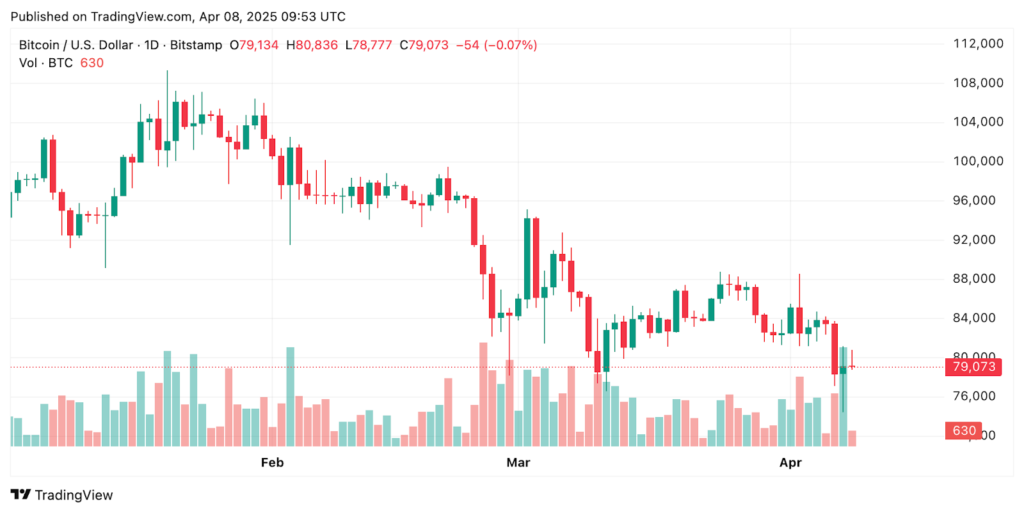Amid escalating tensions surrounding China’s counter tariffs, BitMEX co-founder Arthur Hayes has asserted that Bitcoin and other cryptocurrencies may stand to gain from the ongoing trade conflict.
In a number of posts on the social media platform X (previously known as Twitter), Hayes posited that China’s anticipated reaction to the new U.S. tariffs could involve a devaluation of the yuan.
This scenario could trigger a capital flight into cryptocurrencies, reviving a pattern that has previously bolstered Bitcoin in times of economic turmoil in China.
Hayes cited historical instances where capital outflows from China, following currency devaluations and trade conflicts, contributed significantly to Bitcoin’s bull markets.
If not the Fed then the PBOC will give us the yachtzee ingredients. CNY deval = narrative that Chinese capital flight will flow into $BTC. It worked in 2013, 2015, and can work in 2025. Ignore China at your own peril. pic.twitter.com/LAOeQZEjZt
— Arthur Hayes (@CryptoHayes) April 8, 2025
Hayes Identifies Yuan Devaluation as a Key Opportunity for Bitcoin and Crypto
The United States recently intensified trade tensions by imposing a sharp 34% tariff on all imports from China, prompting an immediate response from Beijing.
In retaliation, China announced matching 34% tariffs on American products, characterizing the U.S. actions as economic coercion, and declared its commitment to “fight to the end.”
China will impose 34% tariffs on all US imports starting April 10. This follows Trump’s announcement of a similar tariff on all Chinese goods entering the US. China labeled the US actions as “unilateral bullying” that undermines the principles of international trade. pic.twitter.com/jz5S4uqmZG
— Complex (@Complex) April 4, 2025
This exchange of aggressive policies has shaken global equity markets and prompted a reevaluation of strategies within the Chinese central bank.
According to Hayes, a depreciating yuan is likely the most viable retaliatory measure that Beijing can undertake without triggering further escalation.
“Xi’s significant tool is a discretionary monetary policy, which necessitates a weaker yuan,” Hayes remarked, highlighting that the yuan’s decline relative to the U.S. dollar is nearing five-year lows.
This sentiment is echoed by Bybit CEO Ben Zhou, who noted that a yuan devaluation is consistent with historical trends and that such strategies have historically resulted in increased demand for Bitcoin among Chinese investors.
Translation: US vs China tariff war… China will try to lower RMB to counter the tariff; historically, whenever RMB drops, a lot of Chinese capital flows into BTC, which is bullish for BTC. https://t.co/OQ4wtSdDWQ
— Ben Zhou (@benbybit) April 8, 2025
Navigating a Volatile Crypto Environment Amid Market Decoupling
As macroeconomic chaos unfolds, Bitcoin finds itself in a volatile climate. Over the past week, BTC has faced a 9.1% downturn, dipping below its previous five-month low and testing the $74,500 support level before recovering.
It closed on Sunday beneath the key $78,500 threshold, unable to maintain momentum above the essential Bull Market Support Band.
Daan Crypto Trades highlighted that this technical level has consistently served as an indicator of market momentum.
$BTC Trading below its Bull Market Support band for the past few weeks. It has attempted to regain this level several times but has faced rejections. This is a useful metric for assessing high-timeframe market momentum. So far this cycle, price has traded below it shortly… pic.twitter.com/LKeX4bvWEe
— Daan Crypto Trades (@DaanCrypto) April 7, 2025
Each time Bitcoin has dropped below this level during the current cycle, it has managed to rebound within a 20% range. However, failure to reclaim this level soon could result in further declines.
Market analyst Rekt Capital further elaborated that Bitcoin’s current correction is approaching the magnitude of the post-halving retracement of -33%. Since reaching its all-time high of $108,786 in January, Bitcoin has experienced a decline of approximately 31%. He suggests that the price may need to drop to the $70,000 zone before finding a bottom.
#BTC As a result, historical Daily RSI trends in this cycle indicate that a price range between current levels and ~$70,000 is likely to represent the bottom of this correction. $BTC #Crypto #Bitcoin https://t.co/tHobd5BWpy pic.twitter.com/0WgOx5D3Yh
— Rekt Capital (@rektcapital) April 7, 2025
Analysis of the RSI (Relative Strength Index) supports this bearish sentiment. Rekt Capital notes that historically, price bottoms tend to occur between 0.3% and 8.4% below the initial RSI low. Under similar conditions, Bitcoin could potentially fall to as low as $69,000.
Furthermore, Rekt Capital stressed the need for Bitcoin to recover the $78,500 level to establish a foundation for a potential recovery.
#BTC Whenever Bitcoin’s Daily RSI dipped to sub-28 RSI levels – that wouldn’t necessarily define the price bottom. Historically, the actual price bottom would be -0.32% to -8.44% lower than the price where the RSI first bottomed. Bitcoin is currently forming its… https://t.co/hvvpOZtMoA pic.twitter.com/tgYYw0SswS
— Rekt Capital (@rektcapital) April 7, 2025
A failure to regain this level, followed by a daily close below it, could signal continued downside pressure, potentially leading to a retest of pre-halving highs in the $69,000 to $72,000 range.
Despite the recent market drop, Bitcoin is currently trading at $79,025, up 2.3% for the day. If it can maintain support, a short-term rebound may be on the horizon.
China’s Strategic Stance Amid Economic Challenges
China’s current resistance extends beyond mere economic competition; the nation is cultivating a narrative of strength and resilience, asserting its capacity to endure financial pressures resulting from tariffs.
In official communications and state media, Beijing maintains that this challenging period represents an opportunity for growth rather than vulnerability.
This stance, however, raises the possibility that China may continue to leverage monetary policy as a weapon, potentially through further yuan devaluation, to counter U.S. actions.
If this course materializes, as suggested by Arthur Hayes, Bitcoin could once again emerge as a refuge for capital looking to safeguard against currency devaluation.
The post Arthur Hayes Says China’s Tariff Response Could Drive Capital Into Crypto – Here’s Why appeared first on Cryptonews.


























